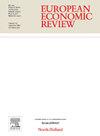On explaining why the (human) world is rich
IF 2.8
2区 经济学
Q1 ECONOMICS
引用次数: 0
Abstract
The wealth of the modern world is a natural historical marvel. Explaining it has traditionally been the purview of economic historians, as exemplified by the recent book How the World Became Rich by Mark Koyama and Jared Rubin. Economic historians, though, tend to only ask process-oriented “how” and “by what means” questions of the Great Enrichment. The eight co-authors of Explaining Technology, who are not economic historians, engage the debate asking a different question. Their goal is to explain the exponential shape of our enrichment with a model of the combinatorial evolution of technology. With an eye toward how we ask questions of the Great Enrichment, I propose broadening our inquiries to include questions typically overlooked in modern economic science, namely, “What form does it take? and “For what purpose?”
解释为什么(人类)世界是富有的
现代世界的财富是一个自然的历史奇迹。解释这一问题传统上是经济历史学家的职责范围,马克·小山(Mark Koyama)和贾里德·鲁宾(Jared Rubin)最近出版的《世界如何变得富有》(How the World become Rich)就是例证。然而,经济历史学家倾向于只问过程导向的“如何”和“通过什么手段”的问题。《解释技术》(explained Technology)一书的8位合著者并非经济历史学家,他们参与了这场辩论,提出了一个不同的问题。他们的目标是用技术组合进化的模型来解释我们财富的指数形状。着眼于我们如何提出大富裕的问题,我建议扩大我们的调查范围,包括在现代经济科学中通常被忽视的问题,即“它采取什么形式?”“为了什么目的?”
本文章由计算机程序翻译,如有差异,请以英文原文为准。
求助全文
约1分钟内获得全文
求助全文
来源期刊

European Economic Review
ECONOMICS-
CiteScore
4.70
自引率
3.60%
发文量
170
期刊介绍:
The European Economic Review (EER) started publishing in 1969 as the first research journal specifically aiming to contribute to the development and application of economics as a science in Europe. As a broad-based professional and international journal, the EER welcomes submissions of applied and theoretical research papers in all fields of economics. The aim of the EER is to contribute to the development of the science of economics and its applications, as well as to improve communication between academic researchers, teachers and policy makers across the European continent and beyond.
 求助内容:
求助内容: 应助结果提醒方式:
应助结果提醒方式:


